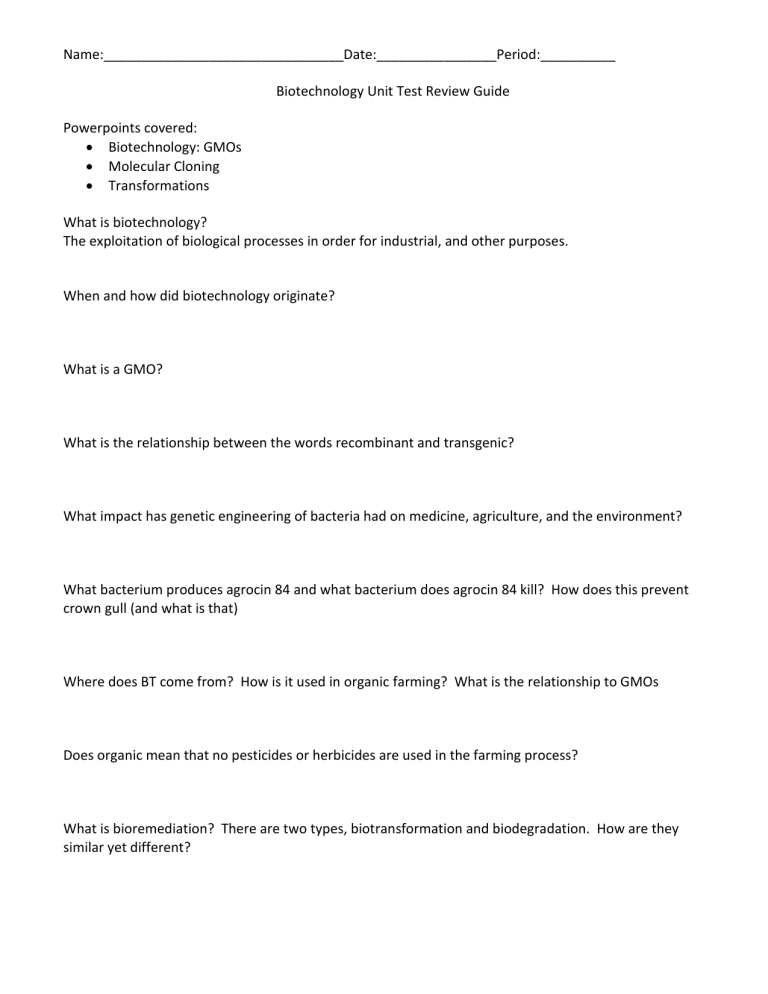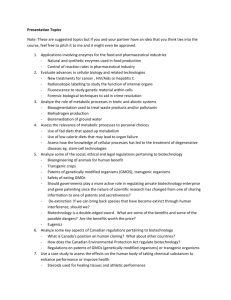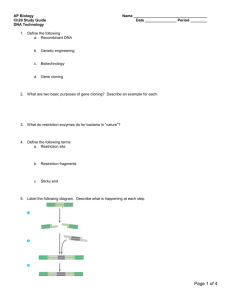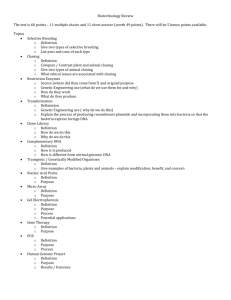Biotechnology Unit Test Review Guide - GMOs, Cloning
advertisement

Name:________________________________Date:________________Period:__________ Biotechnology Unit Test Review Guide Powerpoints covered: Biotechnology: GMOs Molecular Cloning Transformations What is biotechnology? The exploitation of biological processes in order for industrial, and other purposes. When and how did biotechnology originate? What is a GMO? What is the relationship between the words recombinant and transgenic? What impact has genetic engineering of bacteria had on medicine, agriculture, and the environment? What bacterium produces agrocin 84 and what bacterium does agrocin 84 kill? How does this prevent crown gull (and what is that) Where does BT come from? How is it used in organic farming? What is the relationship to GMOs Does organic mean that no pesticides or herbicides are used in the farming process? What is bioremediation? There are two types, biotransformation and biodegradation. How are they similar yet different? Sometimes using GMO bacteria allows for the production of large quantities of a protein through the use of vats. But sometimes transgenic livestock are better? What is the difference? How have plants been genetically modified for agricultural purposes? What is biofuel and how has genetic engineering impacted this product? What are some of the real concerns associated to GMOs? Describe the Grace Booth situation. In what ways can GMOs negatively impact the environment? What percentage of crops grown 100 years ago are grown today? This is a huge loss of what? How does gene cloning differ from reproductive cloning? What are two examples of natural clones? The cloning of whole organisms uses embryo splitting. How is this similar to the formation of monozygotic twins? How did the creation of Dolly differ from the creation of Tetra? How is subcloning different then reproductive cloning? List and describe the steps of subcloning a gene? Understand and describe the process of PCR, gel electrophoresis, and gel extraction. Be able to map a plasmid. Practice here! Restriction Enzyme Used Size of Fragment(s) Obtained Sma I 8 Kb BamHI 11 Kb, 3 Kb, 2 Kb Sma I and BamHI 6 Kb, 5 Kb, 3 Kb, 2 Kb Be able to determine the size of the fragments on an agarose gel. Describe how restriction endonucleases work. Describe the following important features of a plasmid: MCS: Cloning plasmids are designed with specific restriction sites for cutting the plasmid without cutting other important features. Origin of replication (ORI): Allows the plasmid to be replicated by the bacterium for reproduction and maintenance of copy number. Selectable marker: Antibiotic resistance Ampicillin inhibits synthesis of the bacterial cell wall. Amp resistance depends on the production of an enzyme coded for by that gene. only bacteria with that gene will survive. Tetracycline binds 30S subunit of the ribosome Promoter What is bacterial transformation? Describe the process? Who discovered the transformation process and in what year? How does CaCl help the transformation process? What is the purpose of the heat shock procedure? Bacteria that are capable of taking up plasmids are referred to as being _____________________. Understand and describe the role of antibiotics such as ampicillin as selectable markers. What is GFP? Where did it come from originally? What is the difference between fluorescent and chromogenic proteins?



